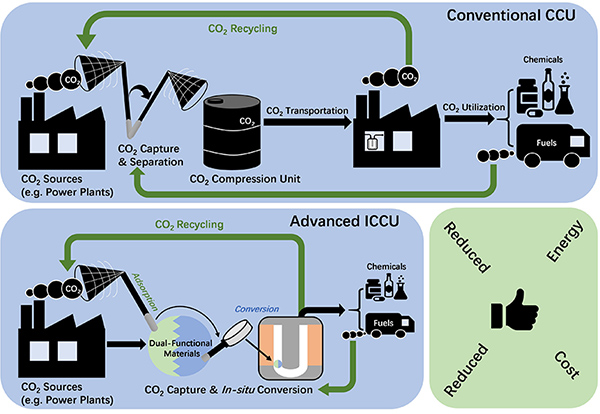The University of Michigan-Shanghai Jiao Tong University Joint Institute (UM-SJTU JI, JI hereafter) Assistant Professor Yulian He and her collaborators have published a review article titled “Emerging Dual-Functional 2D transition metal oxides for carbon capture and utilization: A review” in Fuel, a top chemical energy journal of Netherlands-based Elsevier publishing company.
The published article reviews the advanced 2D transition metal oxides, including their physic/chemical properties, preparation methods, and application examples for carbon capture and utilization. And the review presents the 2D transition metal oxides as an emerging class dual-functional material that own potential high-performance for integrated carbon capture and utilization (ICCU) technology. Yulian He is the corresponding author of this paper. JI postdoctoral researcher Liuqingqing Yang is the lead author. Other authors include Ph.D. candidate Jake Heinlein from Yale University, Assistant Professor Cheng Hua from Antai College of Economics and Management, SJTU, Associate Professor Ruixia Gao from Xi’an Jiao Tong University, Assistant Professor Shu Hu and Professor Lisa Pfefferle from Yale University.

Figure 1. Conventional carbon capture and utilization technology vs. advanced ICCU technology
Carbon dioxide (CO2) is a globally recognized greenhouse gas. Since the Industrial Revolution, a large amount of fossil fuel combustion has led to the continuous increase in the concentration of CO2 in the atmosphere, which has caused a series of climate problems, such as the global warming effect and frequent extreme weather. Therefore, it is urgent to develop an economical and green CO2 capture and utilization (CCU) technology. However, the conventional CCU technology requires compression and purification of captured CO2 (which presents 30% of total energy consumption). Besides, the captured CO2 requires further transportation to the sites for its utilization. Therefore, the processes for the conventional CCU technology are rather complex, leading to poor economic benefits. More recently, ICCU technology has attracted much attention. Compared with the conventional CCU, ICCU technology can realize two catalytic processes of carbon capture and carbon utilization over the same catalyst and use the same operating conditions during the entire process. As a result, there is a significant cost decrease due to the elimination of carbon compression and transportation (see Figure 1). In addition, the CO2 desorption step with high energy consumption in the conventional CCU technology can be replaced by the desorption of the catalytic reaction for further carbon utilization in ICCU, thereby reducing the energy consumption for regeneration of the adsorption site.
Yulian’s team noticed that in the entire ICCU technology, the rational design of dual-functional materials (DFMs) for both carbon capture and utilization is crucial to the final catalytic performance. The team proposes the idea of using the emerging 2D transition metal oxides for the first time as a class of advanced DFMs for ICCU technology. Additionally, based on the existing literature, neither adsorption nor conversion of CO2 over 2D transition metal oxides requires very high operating temperatures. In this case, CO2 capture and in-situ catalytic conversion have been operated simultaneously using the same operating conditions, thereby leading to a significant decrease in energy consumption and cost. Moreover, most of 2D transition metal oxides present high photocalatyic/electrocatalytic properties. For ICCU technology, the combination of photo/electrocatalysis is also one of the important research directions. Last but not least, through diversified chemical modification via surface hydroxyl functional groups, 2D transition metal oxides can be further adjusted for improving the CO2 adsorption selectivity and catalytic conversion performance. Overall, this review summarized the physic/chemical properties, preparation methods, and application examples of 2D transition metal oxides in carbon capture and utilization, showing the perspective of their potential in ICCU technology.
Personal Profile






